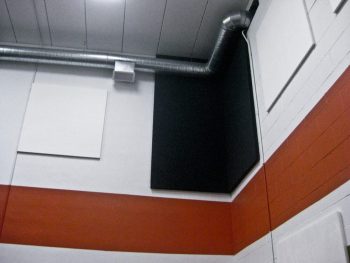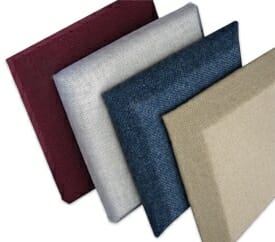Installing a Standard Acoustic Panel
If left acoustically untreated, the acoustical properties of spaces can be significantly diminished. Sound travels so fast that it fills a room almost instantly. It can also propagate from sources in up to 360 degrees, so it’s easy to imagine how a room with flat, highly-reflective surfaces will create a nearly infinite number of sound waves all reflecting in infinite directions and colliding and interfering with each other.

All that reflected sound interferes with and distorts direct sound, generating further patterns of destructive interference – all serving to noticeably diminish your listening experience. Nonetheless, many cost-effective solutions exist to help you shape and control the acoustical properties of any space.
Using Acoustical Wall Panels to Absorb Sound
You can use acoustical wall panels to absorb some of the excess energy of reflected sound along with diffusers that help even-out the sound, resulting in clearer and more-accurate sound imaging in our minds.
By removing some of the reflected sound energy – but not all of it – our ears and brains are better able to focus on the direct sound while the residual reverberation complements our highly-developed perception of depth and location accuracy.
Absorbers
As illustrated in our video, How Sound Works in Rooms, you can use sound absorbers to reduce the strength of the reflected sound energy that would otherwise cause more destructive interference. Acoustical Surfaces offers many customizable, affordable, and highly effective wall panels to fit any acoustical treatment strategy.
Here are a few for your consideration:
 NOISE S.T.O.P. FABRISORB™ fabric-wrapped wall panels are affordable fiberglass sound absorbers that deliver high-performance value at an affordable cost. You can install them on nearly any wall and ceiling surface to reduce echo and reverberation. They come in many color and size combinations and do a great job of taming overly-reflective rooms.
NOISE S.T.O.P. FABRISORB™ fabric-wrapped wall panels are affordable fiberglass sound absorbers that deliver high-performance value at an affordable cost. You can install them on nearly any wall and ceiling surface to reduce echo and reverberation. They come in many color and size combinations and do a great job of taming overly-reflective rooms.
CFAB Cellulose Sound Absorber Panels are also cost-effective, offering great performance at a low price. They control and deaden noise and reduce airborne sound transmission. In addition, they are Class A Fire Rated, resist mold growth, and are easy to install.
Sound Silencer™ acoustical panels are also Class A fire rated with STC and NRC ratings alike. These panels provide high-performance sound blocking and absorption.
Installing a Standard Acoustic Panel
In this section, you’ll find step-by-step instructions showing you how to install acoustic panel. For visual reference, you can also view our instructional video, Installing a Standard Acoustic Panel.
Materials and Equipment
- Echo Eliminator Wall Panels
- Tool to puncture inner seal of adhesive cartridge
- Noise S.T.O.P.™ Contact Adhesive Spray
- Measuring tape
- Titebond GREENchoice Panel
- Marking pencil
- Subfloor Adhesive
- Level
- Caulking gun
- Utility knife
Determine the area where the panel is to be installed on the wall surface.
Measuring and Marking the Wall to Place your Panel in the Desired Location
- Measure and mark distance to top of panel from ceiling – OR – from center of desired panel location
- Measure and mark distance to one edge (side/horizontal) of panel location from nearest boundary (door frame, adjacent wall, etc.)
- Mark horizontal line at top mark with a level (line length should be slightly shorter than panel dimension)
- Mark the vertical line at edge distance with a level (line length should be slightly shorter than panel dimension)
Applying Adhesive to the Back of the Panel
- Use a caulking gun to lay a bead of adhesive around the entire perimeter, about 1-1/2” from the edge with Titebond GREENchoice Panel & Subfloor Adhesive on the back surface of the panel.
- Lay a bead of Panel adhesive from corner to corner within the previously-applied rectangular adhesive perimeter creating an “X” pattern in the center.
- Apply Noise S.T.O.P.™ Contact Adhesive Spray inside the 4 empty spaces between the adhesive lines of the perimeter and “X” adhesive beads you just applied.
Note: DO NOT allow Contact adhesive to overspray Panel adhesive bead lines! Allow the spray adhesive to set for 4 minutes before attaching the panel to the wall.
Attaching the Panel to the Wall
- Align panel edges to side vertical line and top horizontal line.
- Apply even and firm pressure on the side & top to set edge adhesive.
- Apply even and firm pressure to set adhesive for remaining area.
- Repeat steps 1 through 3 for the rest of your wall panels until complete.
Conclusion
Whatever your acoustical project is, we can help you with know-how, experience, design ideas, and a wide range of leading-edge acoustical products.
For further blogs, tutorials, and product descriptions, please visit us at AcousticalSurfaces.com or contact us. One of our representatives will always be happy to help you with any questions you may have.



